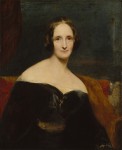 The notebooks in which Mary Shelley wrote the first draft of Frankenstein, complete with her husband Percy Shelley’s notes and edits, have been digitized and uploaded to The Shelley-Godwin Archive. This is the first step in a very exciting project for lit nerds that seeks to digitize the manuscripts of every luminary in this luminous family: novelist Mary Wollstonecraft Shelley, her husband and Romantic poet Percy Bysshe Shelley, her philosopher father William Godwin, and her pioneering early feminist mother Mary Wollstonecraft.
The notebooks in which Mary Shelley wrote the first draft of Frankenstein, complete with her husband Percy Shelley’s notes and edits, have been digitized and uploaded to The Shelley-Godwin Archive. This is the first step in a very exciting project for lit nerds that seeks to digitize the manuscripts of every luminary in this luminous family: novelist Mary Wollstonecraft Shelley, her husband and Romantic poet Percy Bysshe Shelley, her philosopher father William Godwin, and her pioneering early feminist mother Mary Wollstonecraft.
The archive went live on Halloween, appropriately enough, starting off with a bang by uploading the Frankenstein notebooks which have been in the University of Oxford’s Bodleian Library since 2004. The Bodleian has a vast archive of papers from the Godwin-Shelley family, a collection that began in 1893 when Lady Shelley, widow of Mary and Percy’s son Sir Percy Shelley, donated a full third of the family archive to the library and opened the Shelley Memorial at University College, Oxford, with its remarkable marble sculpture of a nude, dead Shelley washed up on the shore of Viareggio.
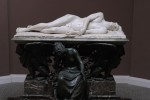 Lady Shelley died in 1899, leaving two-thirds of the remaining family archive to her husband’s cousin and the last third, including the Frankenstein notebooks, to her two eldest grandsons, Shelley Scarlett and Robert Scarlett. They both died childless, so their chunk of the family papers went to their brother Hugh, the 7th Baron Abinger. Hugh’s son James loaned the papers to the Bodleian starting in 1974. After his death in 2002, his son James decided to sell the papers and gave the library the right of refusal. The Bodleian launched a fundraising campaign that culminated in 2004 with the purchase of the Abinger archive and the final reunion of the great Shelley-Godwin archive.
Lady Shelley died in 1899, leaving two-thirds of the remaining family archive to her husband’s cousin and the last third, including the Frankenstein notebooks, to her two eldest grandsons, Shelley Scarlett and Robert Scarlett. They both died childless, so their chunk of the family papers went to their brother Hugh, the 7th Baron Abinger. Hugh’s son James loaned the papers to the Bodleian starting in 1974. After his death in 2002, his son James decided to sell the papers and gave the library the right of refusal. The Bodleian launched a fundraising campaign that culminated in 2004 with the purchase of the Abinger archive and the final reunion of the great Shelley-Godwin archive.
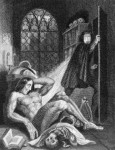 The Bodleian has a wonderful online exhibit about the Shelley-Wollstonecraft-Godwin papers and memorabilia that includes high resolution scans of the Frankenstein notebooks. You can flip through both volumes page by page, zoom in on details and do your best to decipher Mary and Percy’s handwritings. If you’re going to expend that kind of effort, however, wouldn’t it be cool if you could add your decipherings to a transcript? What if you could categorize Mary’s text and Percy’s to make them separately searchable?
The Bodleian has a wonderful online exhibit about the Shelley-Wollstonecraft-Godwin papers and memorabilia that includes high resolution scans of the Frankenstein notebooks. You can flip through both volumes page by page, zoom in on details and do your best to decipher Mary and Percy’s handwritings. If you’re going to expend that kind of effort, however, wouldn’t it be cool if you could add your decipherings to a transcript? What if you could categorize Mary’s text and Percy’s to make them separately searchable?
That’s where the Shelley-Godwin Archive comes in to the picture. A collaborative effort between the New York Public Library, the Maryland Institute for Technology in the Humanities, the Bodleian, Harvard University Library, the Huntington Library and the British Library, the Archive wants to enlist crowd power to create clean, searchable transcripts of the Frankenstein notebooks. Here’s how it works: click on Frankenstein on the header menu and select a manuscript. You can choose from Mary’s original two notebooks, the fair copy (a clean copy in her hand which she sent to publishers) or her notebook pages arranged according to the original three volumes of the first edition of Frankenstein. Click on the manuscript of your choice and you’ll get a thumbnail view of pages from the notebook. When you hover over the thumbs, you’ll see either a red dot indicating no transcript has been made yet, a yellow dot meaning that there’s an unvetted transcript or a green dot meaning the transcript is complete.
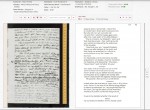 Clicking on one of the thumbnails will take you to a split screen editor where you can read the manuscript page on the left and read or work on the transcript on the right. If the transcript has already been done, you can click a button to view only Mary’s writing with Percy’s edits greyed out and vice-versa. That is such a great feature for scholars and readers in general interested in the question of how much influence Shelley had over Mary’s writing. It’s been almost two centuries since Mary dreamed of a reanimated corpse haunting its creator on a fitful night in Switzerland, and there are still books being written today about how much of Frankenstein was Mary’s work. Some even argue that he wrote the whole thing and that Mary only copied it for him, as she did with many of his poems.
Clicking on one of the thumbnails will take you to a split screen editor where you can read the manuscript page on the left and read or work on the transcript on the right. If the transcript has already been done, you can click a button to view only Mary’s writing with Percy’s edits greyed out and vice-versa. That is such a great feature for scholars and readers in general interested in the question of how much influence Shelley had over Mary’s writing. It’s been almost two centuries since Mary dreamed of a reanimated corpse haunting its creator on a fitful night in Switzerland, and there are still books being written today about how much of Frankenstein was Mary’s work. Some even argue that he wrote the whole thing and that Mary only copied it for him, as she did with many of his poems.
You don’t have to be interested in the authorship issue to enjoy the Shelleys interaction in the Frankenstein notebooks. You can catch rare glimpses into their relationship by reading his notes, like when he addresses her directly in the margins as “Pecksie”, his nickname for her. I also find it fascinating just to see how the draft and editing process raised the novel from infant to adult. If you need an editor, you could do a lot worse than Percy Bysshe Shelley.
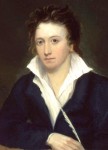 The archive’s next step will be to digitize Shelley’s manuscript of Prometheus Unbound, the four-act lyrical play inspired by Aeschylus’ Prometheus trilogy. After that, more of his assorted manuscripts, and he wrote a huge amount. Mary Shelley collected his manuscripts after his death and, once Percy’s father Sir Timothy allowed her to, she edited the first four-volume edition of his poems and a two-volume edition of his prose. It was a long, exhausting job going through piles of unfinished scraps and notes, many of them close to illegible. Her edits have been criticized — she cut out parts she worried would make him look bad, like his atheism — but it was a Herculean effort that probably nobody else could have done.
The archive’s next step will be to digitize Shelley’s manuscript of Prometheus Unbound, the four-act lyrical play inspired by Aeschylus’ Prometheus trilogy. After that, more of his assorted manuscripts, and he wrote a huge amount. Mary Shelley collected his manuscripts after his death and, once Percy’s father Sir Timothy allowed her to, she edited the first four-volume edition of his poems and a two-volume edition of his prose. It was a long, exhausting job going through piles of unfinished scraps and notes, many of them close to illegible. Her edits have been criticized — she cut out parts she worried would make him look bad, like his atheism — but it was a Herculean effort that probably nobody else could have done.
It very important to her that Percy be recognized for his immense talents, as he really hadn’t gotten much love by the time of his death. Collecting the papers of her remarkable parents was also very important to her. Mary Shelley started the Shelley-Godwin Archive back when it was all paper, and now that it’s pixels, we can all help curate it.
I have never personally read Frankenstein (I am a creepy movie/book wimp) but I think it would be great if they did that for more books and authors…..